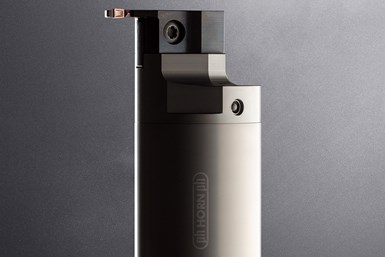Adjustable Damped Boring Bar Enables Vibration-Free Grooving Process
The boring bar can be precisely set according to the vibration occurring in each application.
Precise adjustment of the damping element in the boring bar enables vibration-free grooving. Photo Credit: Horn/Sauermann
Horn’s Adjustable Damped Boring Bar can be adjusted to the vibration amplitudes that occur. Precise adjustment of the damping element in the boring bar enables a vibration-free grooving process. This results in better surface quality without chatter marks and a significant increase in tool life.
The bar is designed to address long tool overhangs that can cause a turning tool to oscillate when boring internal geometries. In addition to the resulting chatter marks on the surface, these vibrations also lead to a significant reduction in tool life. For unfavorable length/diameter ratios, the experienced machinist relies on vibration-damping boring bars, such as Horn’s adjustable damped boring bars, which enable low-vibration machining but can still vibrate during certain machining operations.
The exact adjustment of the damper, made of a carbide rod supported in O-rings, is made from the outside via an adjustment screw. Adjustment is achieved by fine-tuning the pre-tension of the O-rings. This enables the boring bar to be precisely set according to the vibration occurring in each application.
As standard, Horn offers the tools from stock in the length/diameter ratios 5X diameter and 8X diameter. Higher ratios are possible as special tools. For the grooving processes, Horn offers the S224 double-edged grooving system. The Horn cassette system BK 224 ensures a stable interface between the boring bar and the inserts. To further increase process reliability, the boring bars are equipped with an internal coolant supply.
Related Content
-
Making Micro Threads
Production of micro threads can be challenging, but using the most suitable tools for a given application can simplify the task.
-
Shop Sets its Sights on Precise Tool Alignment
A Wisconsin shop has found that visual tool alignment technology has improved tool life and surface finishes for its Swiss-type lathes while increasing throughput as well.
-
Repeatability and Rigidity Are Key for Quick-Change Swiss Tooling
A rotary wedge clamping system is said to enable this two-piece, modular tooling system for Swiss-types to offer the performance of a solid tool.
.png;maxWidth=970;quality=90)












.png;maxWidth=300;quality=90)
